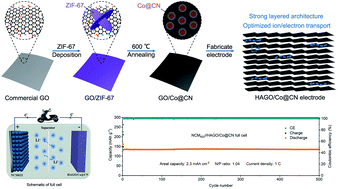Metal–organic-framework derived Co@CN modified horizontally aligned graphene oxide array as free-standing anode for lithium-ion batteries†
Abstract
Graphene-based 2D materials have shown extraordinary promise in electrochemical energy storage owing to their high electrochemical activity, fast carrier mobility, and large electronic conductivity. However, the low specific capacity (<200 mA h g−1) and limited ion transport in thicker electrodes seriously obstruct their practical application. Here, we report the use of a metal–organic-framework derived Co@CN modified horizontally aligned graphene oxide (HAGO/Co@CN) array as a free-standing anode to address this problem and realize a stable cycling at high areal capacity (>5 mA h cm−2). The highly interpenetrating graphene oxide network in the HAGO/Co@CN electrode accelerates electronic transport. In addition, benefiting from the advanced layered architecture, the HAGO/Co@CN electrode exhibits excellent structural stability and thickness-independent electrochemical performance. By systematically adjusting the orientation of GO/Co@CN nanosheets inside the electrode, we optimized the electron/ion transmission to deliver high areal capacity and high-rate capability at high mass loading. More importantly, a designed full cell with a NCM622 cathode and a HAGO/Co@CN anode shows an ultrahigh capacity retention of >98% at 1C after 500 cycles with a commercial-level reversible capacity of 2.3 mA h cm−2.

- This article is part of the themed collection: Journal of Materials Chemistry A HOT Papers


 Please wait while we load your content...
Please wait while we load your content...